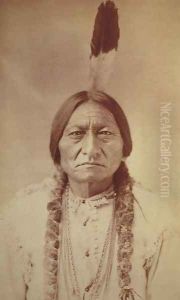David Frances Barry Paintings
David Frances Barry, born in 1854 in upstate New York, was an American photographer renowned for his documentation of the American West, particularly his portraits of Native American figures, which have become some of the most iconic images of the era. Barry's journey into photography began in his early 20s when he started working as an assistant in a photographer's studio. His keen interest and skill in the craft quickly grew, leading him to establish his own studio in the Dakota Territory, strategically located near the Standing Rock Agency. This location provided him unparalleled access to the indigenous tribes of the Great Plains, most notably the Lakota (Sioux), during a period of immense change and conflict in their history.
Barry's work is distinguished by his commitment to capturing the individual personalities and dignities of his subjects, at a time when Native Americans were often dehumanized by popular culture and government policies. His portraits of figures such as Sitting Bull, Gall, Rain-in-the-Face, and Red Cloud have been celebrated for their depth and sensitivity. Barry not only photographed these leaders and warriors but also documented the everyday life and ceremonies of the Lakota people, offering a rare and valuable perspective on their culture.
Throughout his career, Barry traveled extensively, taking his camera to various reservations and battlegrounds, amassing a vast collection of photographs that serve as an important historical record. Despite the popularity of his work, Barry faced financial difficulties and eventually sold his collection. His photographs, however, continue to be highly regarded for their artistic and historical significance.
David Frances Barry's legacy lies in his contribution to the preservation of a critical chapter in American history through his photographs. His work provides insight into the lives of Native Americans during the late 19th and early 20th centuries, bridging a gap between cultures and generations. Barry died in 1934, but his photographs endure as a testament to his skill, empathy, and pioneering spirit in the field of photography.
